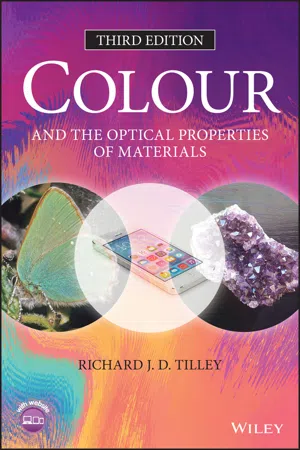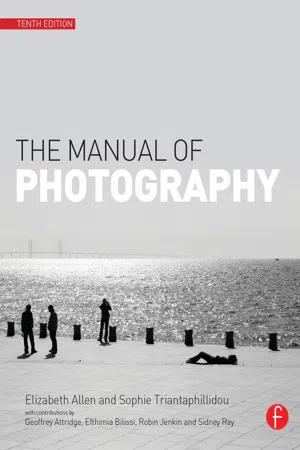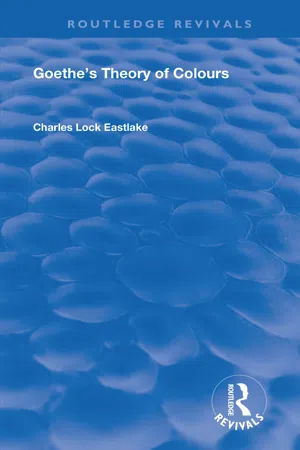Chemistry
Ion Colours
Ion colors refer to the characteristic colors exhibited by ions in solution or in solid state due to their interaction with light. These colors are a result of the absorption and emission of specific wavelengths of light by the ions, which is influenced by their electronic structure and energy levels. The study of ion colors is important in analytical chemistry and can provide valuable information about the composition and properties of substances.
Written by Perlego with AI-assistance
Related key terms
5 Key excerpts on "Ion Colours"
- eBook - ePub
Principles of Colour and Appearance Measurement
Object Appearance, Colour Perception and Instrumental Measurement
- Asim Kumar Roy Choudhury(Author)
- 2014(Publication Date)
- Woodhead Publishing(Publisher)
An important constraint on all interactions of electromagnetic radiation with matter is the quantum mechanical rule that says atoms can have only certain discrete states, each with a precisely defined energy; intermediate energies are forbidden. Each atom has a lowest possible energy, called the ground state, and a range of excited states of higher energy. The allowed energy states are like the steps of a ladder, although their spacing is highly irregular. Light or other radiation can be absorbed only to emit light of any arbitrary energy, since quantum theory explains that only certain energy states if it carries precisely the right amount of energy to promote an atom from one step to a higher step. Similarly, when an atom falls from an excited state to a lower energy state, it must emit radiation that will carry energy equal to the difference in energy between the two levels. The energy releases as photon or quantum of light, whose frequency and wavelength are determined by the energy difference. The states that are of the greatest importance in the analysis of colour represent various possible energy levels of electrons. Each electron must occupy an orbital, which describes a particular geometric distribution of the electron’s charge around the atomic nucleus. The orbitals are in turn organised in shells. The electrons in any filled or closed shell form pairs, and they have a notably stable configuration. A large quantity of energy is needed to promote one of the paired electrons from a closed shell to the next vacant position of the ladder. Ultraviolet or even X-ray may be able to provide the huge energy required for such transition. Closed shells, therefore, have no direct influence on the colour of the materials. The colour usually results from the transition of unpaired electrons, usually the outermost ones. They are the valence electrons, the ones that participate in chemical bonds.The mechanisms of colour generation are remarkably diverse. Various causes for an object or light appearing to be coloured have been intensively studied, analysed and classified by Nassau (1983 , 1987) . He identified five fundamental mechanisms and 15 causes for the generation of colour, acknowledging that some overlaps and arbitration among the proposed causes are inevitable. The fundamental mechanisms of colour generation can be classified into 5 groups and 15 categories, as shown in Table 2.1 .Table 2.1Fifteen causes and five mechanisms of colour generation (Nassau, 1983 )Electrons are involved in all the mechanisms. In other words, electrons are responsible for creating coloured objects or light. It is not sufficient to know the composition of a substance to decide on its colour. It is commonly known that cobalt generates a deep blue colour. However, several deep blue-coloured gemstones are available which are not composed of cobalt, and several other factors are responsible for their blue colour. Chromium-containing substances may have different colours. Chloride, bromide, fluoride and iodide of chromium are violet, olive green, green and black respectively. Ammonium dichromate is orange in colour, whereas potassium chromate is yellow. Different chromium-containing gemstones are differently coloured – for instance, emerald is green, ruby is red, whereas alexandrite is red in incandescent light and green in daylight. - eBook - ePub
- Richard J. D. Tilley(Author)
- 2019(Publication Date)
- Wiley(Publisher)
f are all forbidden. This has considerable importance for the operation of lasers, as forbidden transitions (i.e. transitions with a low probability) are associated with energy states with long lifetimes. These are necessary to obtain the population inversions needed for laser action.The exact arrangement of the energy levels in an atom is very sensitive to the electron configuration. When this constraint is coupled to the selection rules operating, it emerges that the line spectrum of each chemical element is unique. Thus, the spectrum becomes a powerful analytical tool. Each atom or ion can be thought of as having a line spectrum fingerprint that can be used as a diagnostic test for the element.At the simplest level, this is made use of in inorganic chemistry as a ‘flame test’. A small quantity of the material being examined is placed on a platinum wire and heated to high temperature in a flame. The colour of the flame is a guide to the atoms present. This method works well with the alkali metals and alkaline earth metals, which produce clearly identifiable colours (Table 7.2 ).At this point, it is well to be aware that the colours produced in a flame, or in fireworks, which are similar, are the result of complex interactions and frequently arise from molecular species rather than isolated atoms or ions. Thus, the scarlet colour arising from lithium compounds is due to radiation from LiOH molecules rather than isolated Li or Li+ . Green colours from barium compounds are derived from the molecular species BaCl+ and BaOH+ , and the red of strontium compounds derives from SrOH+ and SrCl+ rather than Sr or Sr2+ . The same could be said about other flame and firework colours. Colour from molecules is described in the following chapter.Much more information about the colours given out by the flame can be obtained by allowing the light to pass through a narrow slit and viewing it with an inexpensive plastic diffraction grating. The grating spreads the light out into a series of spectra, which in the case of atoms or ions consist mainly of lines and in the case of molecules also contains bands (Chapter 8 ). In fact, such an arrangement is a simple spectroscope. The technique can yield more information if the intensities and positions of the lines in the spectrum can be recorded, and it is this technique that allows one to determine that molecular species are important in flame colours rather than isolated atoms or ions. Comparison of the intensities of lines with those from standard solutions of ions allows quantitative analysis of even very small quantities of impurities to be made. The technique is called atomic absorption - Kevin Reel, Derrick C. Wood, Scott A. Best(Authors)
- 2014(Publication Date)
- Research & Education Association(Publisher)
15Descriptive and Organic Chemistry
Colors of Aqueous Solutions
Many aqueous solutions are clear, while others have a distinct color. The colors of popular species are given in the following table:Species Color Ni+2Green Mn+2Pinkish/purple Cr+3Navy blue Cu+2Royal blue Co+2 , Co+4Blue/pink Fe+2Rusty yellow/orange CrO,−2Yellow Cr2 O7 −2Orange MnO4 −Purple I−Yellow Br−Colorless Br2(ℓ )Brownish l2(a)Purple Cl2(g)Yellowish-green TEST TIP On the AP Chemistry exam you should be able to identify the color associated with a particular molecule or ion. This is a popular subject for questions in the multiple-choice section.Colors of Ions in a Flame Test
When metallic ions are placed in a flame, the electrons are promoted to excited states and subsequently fall back down to the ground state, giving off specific wavelengths of light. These different wavelengths result in colors that correspond to the primary and dominant electron transitions. Flame tests are useful as a means for identifying ions in unknown compounds because the color of the flame is much like a fingerprint for an ionic compound. The colors associated with popular cations are listed in the following table.Ion Color Li+Red Na+Yellow K+Purple Cu+2Teal Ca+2Orange Ba+2Green Sr+2Red DID YOUKNOW?The active ingredients in sunscreens are organic molecules that absorb ultraviolet light from 290–400 nm. In general, it is the presence of benzene rings and other double bonds that absorb these specific energies of light—acting as a barrier between harmful UV rays and your skin.TEST TIPSimilar to the colors of aqueous solutions, flame test colors would most likely show up in the multiple-choice section. They are also a valuable way of distinguishing compounds in a qualitative analysis.- eBook - ePub
- Elizabeth Allen, Sophie Triantaphillidou(Authors)
- 2012(Publication Date)
- Routledge(Publisher)
psychophysical phenomenon (i.e. a sensory response resulting from a physical stimulus) or simply an aspect of visual perception. Working with colour imaging has made the classification of colour and its description in terms of numbers essential. Several systems have been devised over the years for the purpose. The Commission Internationale de l’Éclairage (CIE, or International Commission of Illumination) methods are widely adopted and will be the main focus of this chapter. The CIE has, since its inception in 1913, developed standards and procedures of metrology in the fields of lighting, vision, colour and, more recently, imaging.THE PHYSICS OF COLOUR
We have already seen, in Chapter 2 , that white light can be dispersed by means of a prism into light of different hues – violet, indigo, blue, green, yellow, orange and red, ‘all the colours of the rainbow’ – and that these hues correspond to different wavelengths. The wavelengths of visible electromagnetic radiation range from approximately 380 to 780 nm. In practice, light is never made of a single wavelength but of a narrow band or a large combination of wavelengths. Light consisting of a single wavelength – or a narrow band of wavelengths – is highly saturated in colour. These colours are referred to as spectral colours, or spectral hues. This is an opportunity for us to note that ‘hue’ and ‘colour’ are not the same thing, as we will see next, although the terms are frequently used interchangeably.While Newton identified the seven spectral hues listed above, his descriptions were slightly different from those understood today. In particular he described what we would call ‘blue’ as ‘indigo’ and a ‘blue–green’ (or ‘cyan’), as blue.A revised set of names is shown in Figure 5.1 , which indicates the spectral hues and the corresponding wavelength bands.COLOUR TERMINOLOGY
In this section we provide some important colour terminology that is used throughout this book. The definitions presented are based on definitions from the CIE International Lightning Vocabulary - eBook - ePub
- Johann Wolfgang von Goethe, Charles Lock Eastlake(Authors)
- 2019(Publication Date)
- Routledge(Publisher)
Part IIIChemical Colours Charles Lock Eastlake486.We give this denomination to colours which we can produce, and more or less fix, in certain bodies; which we can render more intense, which we can again take away and communicate to other bodies, and to which, therefore, we ascribe a certain permanency: duration is their prevailing characteristic.487.In this view the chemical colours were formerly distinguished with various epithets; they were called colores proprii, corporei, materiales, vert, permanentes, fixi.488.In the preceding chapter we observed how the fluctuating and transient nature of the physical colours becomes gradually fixed, thus forming the natural transition to our present subject.489.Colour becomes fixed in bodies more or less permanently ; superficially, or thoroughly.490.All bodies are susceptible of colour; it can either be excited, rendered intense, and gradually fixed in them, or at least communicated to them.XXXIV Chemical contrast.
491.In the examination of coloured appearances we had occasion everywhere to take notice of a principle of contrast: so again, in approaching the precincts of chemistry, we find a chemical contrast of a remarkable nature. We speak here, with reference to our present purpose, only of that which is comprehended under the general names of acid and alkali.492.We characterised the chromatic contrast, in conformity with all other physical contrasts as a more and less ; ascribing the plus to the yellow side, the minus to the blue; and we now find that these two divisions correspond with the chemical contrasts. The yellow and yellow-red affect the acids, the blue and blue-red the alkalis; thus the phenomena of chemical colours, although still necessarily mixed up with other considerations, admit of being traced with sufficient simplicity.493.The principal phenomena in chemical colours are produced by the oxydation of metals, and it will be seen how important this consideration is at the outset. Other facts which come into the account, and which are worthy of attention, will be examined under separate heads ; in doing this we, however, expressly state that we only propose to offer some preparatory suggestions to the chemist in a very general way, without entering into the nicer chemical problems and questions, or presuming to decide on them. Our object is only to give a sketch of the mode in which, according to our conviction, the chemical theory of colours may be connected with general physics.
Index pages curate the most relevant extracts from our library of academic textbooks. They’ve been created using an in-house natural language model (NLM), each adding context and meaning to key research topics.




